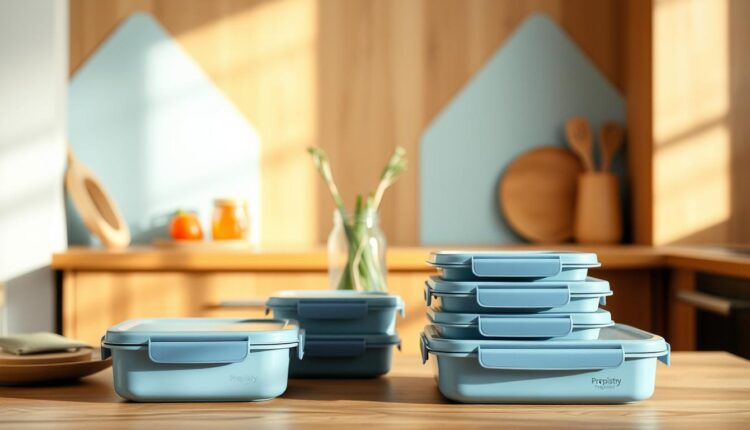Lunch Meal Prep Waste Reduction With Reusable Tools
Reduce waste with our lunch meal prep guide. Discover reusable tools and strategies for a more sustainable meal prep routine, perfect for busy professionals and families.
Did you know the average American throws away nearly 300 pounds of edible food yearly? That’s enough to fill a bathtub twice over. As someone who’s spent years juggling professional kitchens and family dinners, I’ve seen firsthand how small daily choices add up—for both our wallets and the planet.
Creating sustainable routines doesn’t require perfection—just smarter tools and strategies. Durable containers, thoughtful planning, and clever ingredient swaps can transform how we approach midday eating. Even composting plays a role, turning scraps into garden gold rather than landfill clutter.
Key takeaways:
- Strategic planning cuts kitchen stress and environmental impact
- Quality storage solutions save money long-term
- Simple systems work for any schedule or dietary need
Through trial and error (and many soggy sandwiches), I’ve discovered what truly works when life gets hectic. Let’s explore how to build habits that stick—no fancy equipment or hours-long Sunday marathons required.
The Importance of Sustainable Lunch Prep
Picture this: every uneaten carrot stick and forgotten leftovers contribute to 30-40% of America’s food supply ending up discarded. This isn’t just about forgotten groceries—it’s resources like water and energy literally going down the disposal.

Why Our Choices Ripple Beyond the Kitchen
When food decomposes in landfills, it releases methane—a greenhouse gas 25x more potent than carbon dioxide. Through smarter organization and storage, we can shrink this environmental footprint while stretching our grocery budgets further.
Tools That Work as Hard as You Do
Glass jars and stainless steel boxes aren’t just trendy—they’re game-changers. I’ve found that portioning roasted veggies or grains in stackable containers cuts morning chaos. Bonus? They keep contents fresher than plastic wrap ever could.
Start with these simple shifts:
- Map 3 core ingredients to use across multiple dishes
- Designate “use first” fridge zones for perishables
- Batch-cook versatile bases like quinoa or grilled chicken
Remember my disastrous kale overload phase? Now I chop just what I’ll use, storing stems for smoothies. Small tweaks create big change—no fancy systems required.
Small changes make a big difference—strategic planning and quality tools help save money and reduce waste.
Key Benefits of Reducing Food Waste
Imagine your weekly grocery bill shrinking while your fridge stays full—that’s the power of mindful kitchen habits. During my years managing restaurant inventories, I discovered that intentional ingredient use boosts both budgets and flavor profiles. Let’s unpack how trimming excess creates ripple effects far beyond your cutting board.
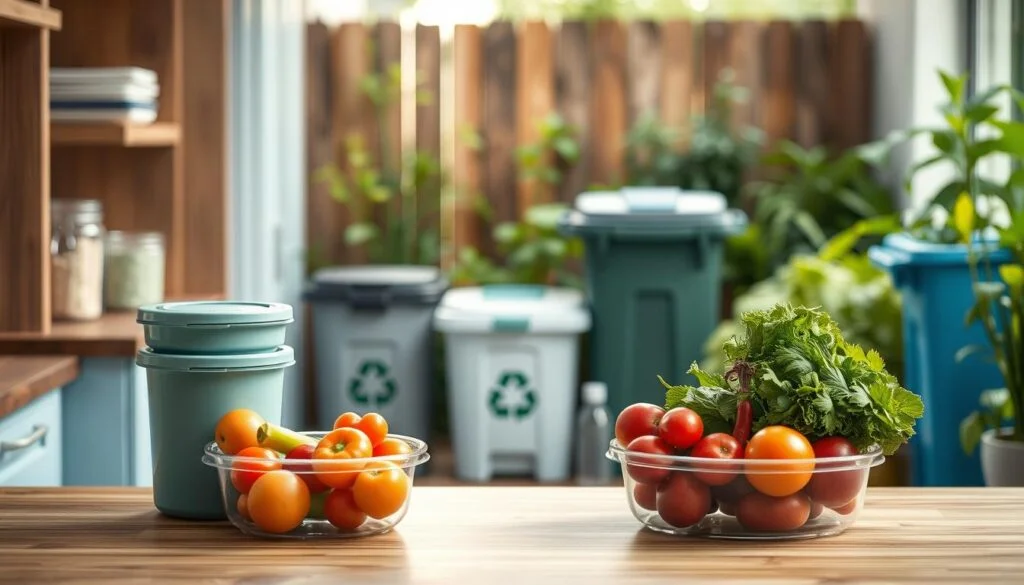
Environmental and Economic Advantages
Every wilted spinach bunch saved from the trash keeps 25 gallons of water from being wasted. I’ve seen households slash $1,300 annually simply by repurposing leftovers into soups or frittatas. Composting peels and cores—my favorite trick—nourishes gardens instead of releasing methane in landfills.
Enhancing Meal Quality and Freshness
Fresh herbs stay crisp for weeks when stored in jars with damp towels. Rotating produce based on shelf life means crunchier veggies and brighter flavors. A clean eating principles approach transformed my roasted root vegetables—using every part from beet greens to radish tops adds unexpected texture and nutrients.
Three immediate perks I’ve witnessed:
- Fewer repeat grocery trips (saves time + gas money)
- Sharper cooking skills through creative ingredient use
- Consistent access to peak-freshness components
Food waste leads to significant greenhouse gas emissions. Every small effort counts in fighting climate change.
Choosing the Right Reusable Tools for Lunch Meal Prep
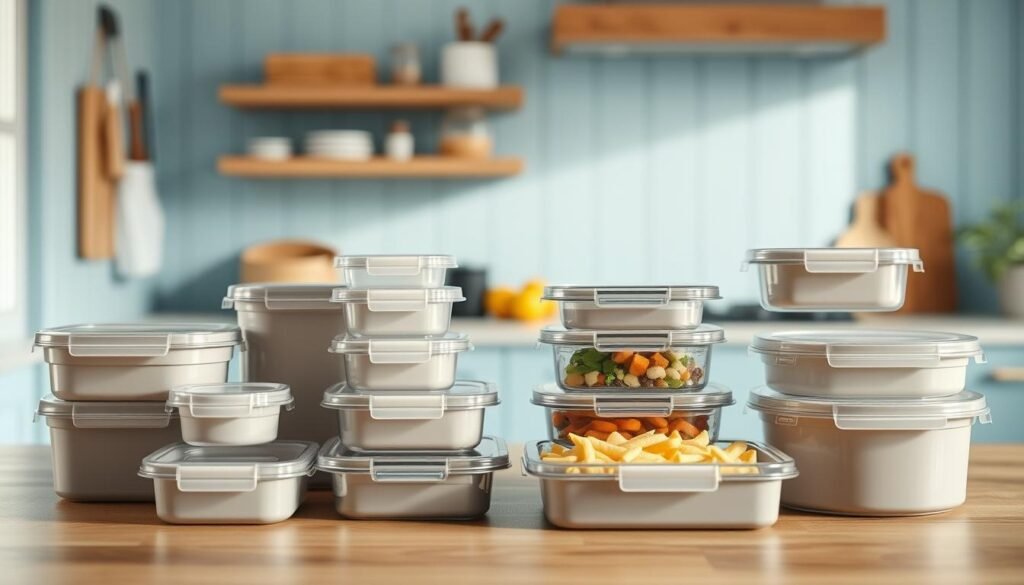
Early in my career, I nearly gave up on eco-friendly kitchen swaps after a week of leaky containers and soggy salads. Then I discovered the magic of intentional tool selection—it’s like finding jeans that fit perfectly and last years.
Container Options and Storage Solutions
Your kitchen arsenal matters more than you think. The right vessels keep ingredients crisp, prevent spills, and maximize fridge space. Let’s break down your options:
| Material | Best For | Lifespan | Eco-Score |
|---|---|---|---|
| Glass | Oven-safe dishes, acidic foods | 10+ years | ★★★★☆ |
| Stainless Steel | Portable meals, temperature control | 15+ years | ★★★★★ |
| BPA-Free Plastic | Lightweight snacks, kids’ portions | 3-5 years | ★★★☆☆ |
Glass jars became my weekday heroes after realizing they stack neatly in small fridges. For busy parents, divided stainless boxes prevent flavor mixing while surviving backpack tumbles.
Three storage hacks I swear by:
- Use clear containers to spot ingredients quickly
- Label lids with erasable markers
- Store dressings in tiny silicone pouches
When shopping, prioritize versatile shapes that nest when empty. I keep a running list of container sizes needed for my go-to recipes—no more guessing games at the store. Remember: durable tools pay for themselves in reduced replacements and fresher ingredients.
Be cautious when using plastic containers; opt for BPA-free or eco-friendly materials to avoid health risks.
Innovative Strategies for Lunch Meal Prep Waste Reduction
What if your weekly grocery haul could fill fewer trash bags while stretching further in your recipes? Let’s rethink how we handle ingredients from store to table. Through years of testing kitchen workflows, I’ve found smart packaging choices and bulk purchases create effortless systems that benefit both your schedule and the planet.
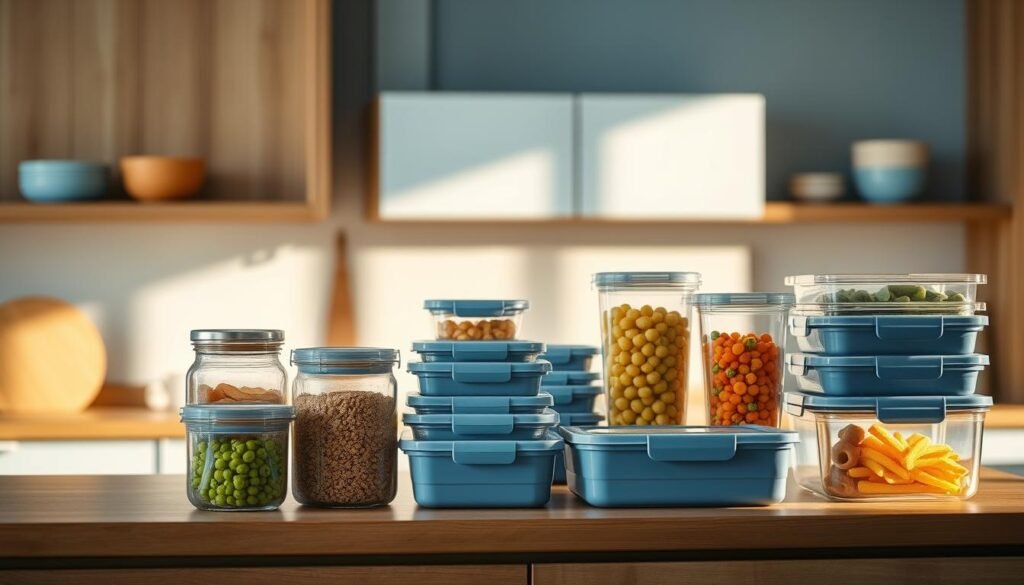
Reusable Packaging Techniques for Every Meal
Transform ordinary containers into multi-purpose tools. Silicone muffin cups separate dressings from salads, while beeswax wraps keep sliced veggies crisp. My favorite hack? Layer grain bowls vertically in wide-mouth jars—quinoa at the bottom, roasted veggies in the middle, greens on top. Just shake before eating!
Utilizing Bulk Buying and Minimal Packaging
Bulk bins became my secret weapon after realizing they cut packaging waste by 80%. Store staples like oats and lentils in clear containers labeled with cooking instructions. This table shows my go-to bulk storage solutions:
| Container Type | Best For | Capacity | Cost Savings |
|---|---|---|---|
| Glass Canisters | Flours & Spices | 4-8 cups | $12/year |
| Mason Jars | Grains & Legumes | 16-32 oz | $18/year |
| Reusable Bags | Nuts & Dried Fruit | 2-5 lbs | $9/year |
Build flexible recipes around these bulk basics. A base of brown rice can become stir-fry bowls, stuffed peppers, or breakfast porridge throughout the week. For more inspiration, explore these zero-waste meal planning methods that adapt to seasonal ingredients.
Three ways to start today:
- Bring cloth produce bags to grocery stores
- Prep “mix-and-match” components like roasted veggies and proteins
- Store chopped herbs in oil-filled ice cube trays
Effective Meal Planning and Prep Techniques
What if your weekly cooking routine felt less like a chore and more like building with LEGO blocks? That’s the magic of the building blocks method—a system I wish I’d discovered before my “spinach mountain” incident (let’s just say frozen greens have limits). This approach turns chaotic cooking into creative assembly.
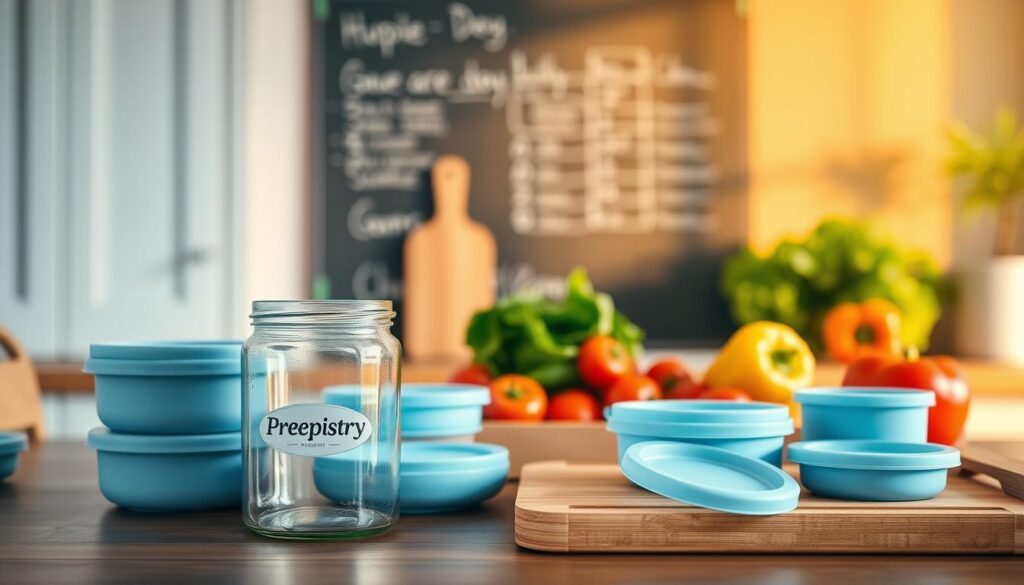
Building Blocks Approach for Flexible Meal Prep
Think of your kitchen like a well-stocked workshop. Start with 3 core components each week:
| Component | Examples | Prep Time |
|---|---|---|
| Proteins | Grilled chicken, baked tofu | 45 mins |
| Grains | Quinoa, brown rice | 30 mins |
| Veggies | Roasted sweet potatoes, sautéed greens | 25 mins |
Mix and match these bases throughout the week. Roasted chicken becomes tacos on Tuesday, then salad topping on Thursday. I keep a “flavor boosters” station with sauces and spices to transform repeats into new experiences.
Incorporating Leftovers and Creative Recipes
“Leftovers are ingredients waiting for their next act,” says chef and food waste advocate Steven Satterfield.
Try these revival tricks:
- Blend roasted veggies into Friday’s pasta sauce
- Turn extra grains into breakfast porridge with cinnamon
- Freeze herb stems in broth for future soups
My 3-step process for stress-free assembly:
- Cook building blocks Sunday afternoon
- Store in clear containers labeled with use-by dates
- Each morning, grab components like puzzle pieces
Remember when I prepped 10 identical salads? Now I make 5 bases and 3 toppings—way more fun. With this flexible framework, you’ll spend less time planning and more time enjoying delicious combinations.
Eco-Friendly Practices: Composting and Zero Waste Lifestyle
Transforming kitchen scraps into nutrient-rich soil feels like magic—but it’s science any home cook can master. My first compost bin was a disaster (think fruit flies and mysterious smells), but now it’s my secret weapon for growing herbs and reducing food waste. Let’s explore simple ways to nourish both your garden and daily routines.
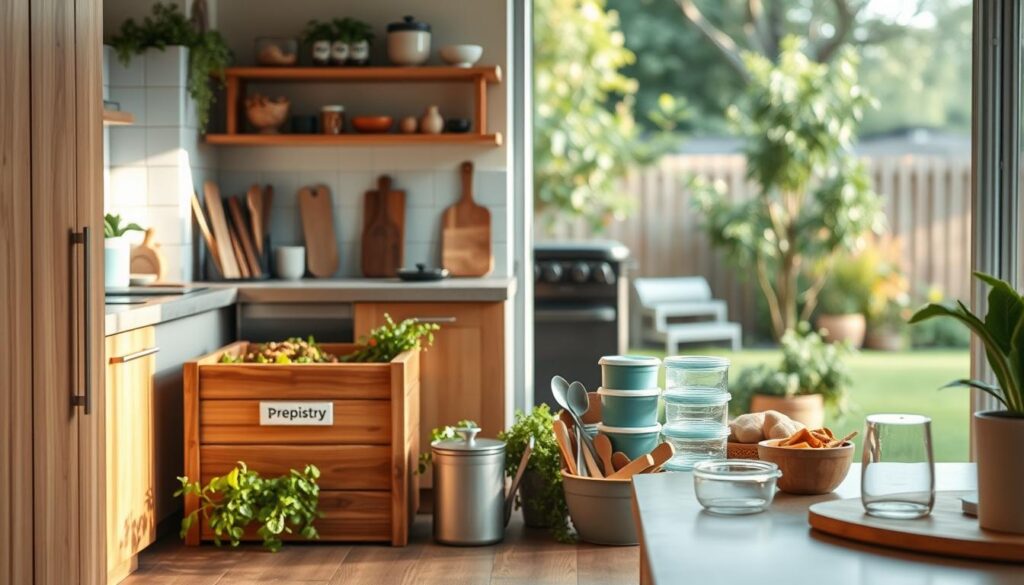
How to Set Up a Backyard Composting System
Start with a 3×3 foot space—even urban balconies work. Layer brown materials (dead leaves) with green (vegetable peels) like lasagna. Avoid meat or dairy to prevent odors. Turn the pile weekly with a pitchfork—it’s my Saturday morning workout.
| Do | Don’t | Why |
|---|---|---|
| Mix coffee grounds | Add glossy paper | Balances nitrogen |
| Chop large pieces | Ignore moisture | Speeds breakdown |
| Use eggshells | Include pet waste | Adds calcium safely |
Integrating Zero Waste Meal Planning Methods
“Composting completes the circle,” says urban farmer Marisa Rodriguez. “It turns yesterday’s carrot tops into tomorrow’s salad ingredients.” Pair this with smart grocery habits:
- Shop bulk bins with cloth bags for grains and nuts
- Plan meals around seasonal vegetables nearing their peak
- Store citrus peels in vinegar for DIY cleaners
When I started freezing herb stems in ice cubes for soups, my food budget stretched further. Remember: every apple core saved from landfills helps fight climate change. What small swap will you try first?
Never compost meat, dairy, or pet waste—these items can attract pests and cause unpleasant odors.
Conclusion
Your journey toward eco-conscious cooking begins with one reusable container. Through strategic planning and quality tools, you’ll discover how simple swaps create lasting change. A well-organized week using versatile ingredients cuts grocery trips and keeps dishes exciting without repetition.
Start small: plan three core recipes that share components. Batch-cook grains on Sunday, then mix with fresh veggies throughout the week. For streamlined mornings, try an organized fridge system that makes grab-and-go options visible.
Remember my container chaos phase? Now I save money and time by storing leftovers in stackable glass jars. Composting peels and repurposing scraps became second nature—your effort adds up, even if progress feels gradual.
Three final tips to spark action:
- Rotate perishables weekly to maintain freshness
- Freeze herb-infused oils for instant flavor boosts
- Celebrate small wins like repurposing roasted veggies into new dishes
Every intentional choice ripples outward. What simple swap will you try this week? Together, we’re building kitchens that nourish both people and the planet—one thoughtful container at a time.
Roasted Vegetable & Quinoa Power Bowls with Lemon-Tahini Dressing
A versatile, waste-conscious lunch bowl that transforms roasted vegetables and quinoa into a nutrient-packed meal. Perfect for batch prep and using up leftover veggies.
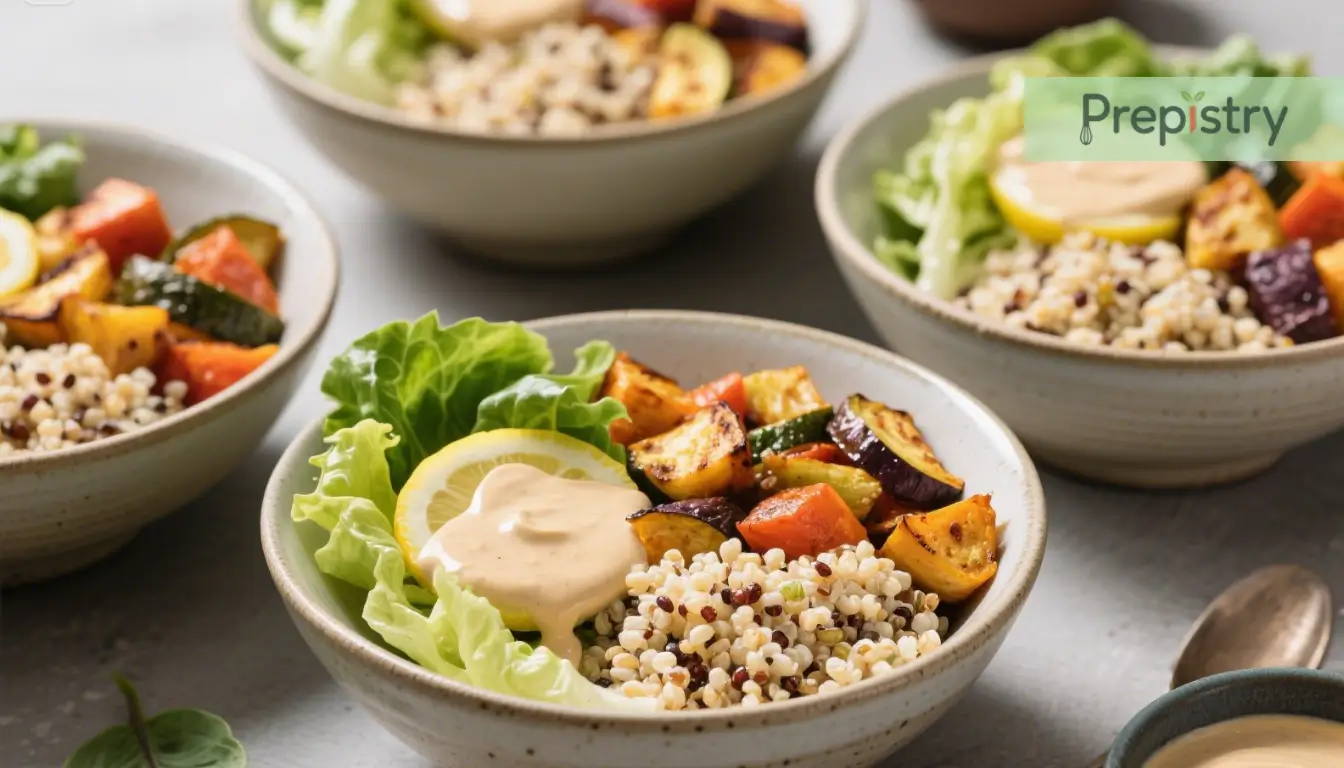
Nutrition Information
Equipment Needed
- Baking sheet
- Glass storage containers
- Mixing bowls
Ingredients
-
2 cups cooked quinoa (about ¾ cup dry)
-
4 cups mixed vegetables (sweet potatoes, bell peppers, zucchini, broccoli, etc.)
-
2 tbsp olive oil
-
1 tsp garlic powder
-
1 tsp smoked paprika
-
½ tsp sea salt
-
1 can (15 oz) chickpeas, drained and rinsed
-
¼ cup tahini
-
2 tbsp lemon juice
-
1 tbsp maple syrup
-
2-4 tbsp water
-
½ cup fresh herbs (parsley, cilantro, or dill)
-
2 tbsp toasted seeds (pumpkin or sunflower)
Instructions
Recipe Video
Seriously Tasty & Fresh Quinoa Salad With Tahini Dressing (Vegan, Minimal Ingredients)
Hello friends! Today we're sharing a recipe that will help up survive the summertime but also provide nourishment and keep us satiated and satisfied! This Quinoa Salad is seriously good and refreshing, completely raw and you only need few ingredients to make it. We know that most people in the summertime prefer lighter, fresh and simple meals that don't require cooking on the stove and that's why salads are a must when it comes to this. We made this recipe completely vegan (vegan feta, maple syrup) but you can use the ingredients that better fits your diet and lifestyle.

